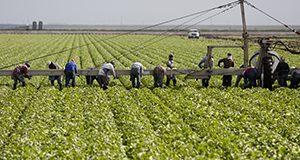Abstract
Good Agricultural Practices (GAPs) and Good Handling Practices (GHPs) encompass the general procedures that growers, packers and processors of fresh fruits and vegetables should follow to ensure the food safety of their product. GAPs usually deal with preharvest practices (i.e., in the field), while GHPs cover postharvest practices, including packing and shipping. We will use the term GAPs in this fact sheet to generally cover pre- and postharvest practices associated with the safe handling of produce, both fresh and minimally processed. This five-page introduction to the Food Safety on the Farm series provides an overview of GAPs and GHPs, summarizing major principles and recommendations of later documents in the series. Written by Jaysankar De, Christopher R. Pabst, Jessica Lepper, Renée Goodrich Schneider, and Keith R. Schneider and published by the UF/IFAS Food Science and Human Nutrition Department.
http://edis.ifas.ufl.edu/fs135
References
Centers for Disease Control and Prevention (CDC). 2018. National Outbreak Reporting System (NORS). https://wwwn.cdc.gov/norsdashboard/. Accessed on February 5, 2019.
Cornell University. 2002. Good Agricultural Practices Network for Education and Training. Ithaca, NY: Cornell University Department of Food Science. https://gaps.cornell.edu/home/. Accessed on February 5, 2019.
Food and Drug Administration (FDA). 1998. Guide to Minimize Microbial Food Safety Hazards for Fresh Fruits and Vegetables. Washington, DC: U.S. Department of Health and Human Services, FDA. https://www.fda.gov/downloads/Food/GuidanceRegulation/UCM169112.pdf. Accessed on February 5, 2019.
Food and Drug Administration (FDA). 2009. Bioterrorism Act 2002. https://www.gpo.gov/fdsys/pkg/PLAW-107publ188/pdf/PLAW-107publ188.pdf. Accessed on February 5, 2019.
Food and Drug Administration (FDA). 2017. FDA Food Safety Modernization Act. http://www.fda.gov/Food/GuidanceRegulation/FSMA/default.htm. Accessed on February 5, 2019.
Food and Drug Administration (FDA). 2018. Produce Safety Standards. https://www.fda.gov/food/guidanceregulation/fsma/ucm304045.htm. Accessed on February 5, 2019.
Food and Drug Administration (FDA). 2019. FSMA Final Rule on Produce Safety. http://www.fda.gov/Food/GuidanceRegulation/FSMA/ucm334114.htm. Accessed on February 5, 2019.
GLOBALG.A.P. 2017. Integrated Farm Assurance Version 5.1. General Crop Rules. Cologne, Germany: GLOBALG.A.P. http://www2.globalgap.org/documents/webdocs/EUREPGAP_IFA-PART_I_V3-0-1_2July07_Clean.pdf. Accessed on February 5, 2019.
United Fresh Produce Association. 2010. Produce GAPs Harmonization Initiative. Washington, D.C.: United Fresh Produce Association. https://www.unitedfresh.org/food-safety/gap-harmonization-initiative/. Accessed on February 5, 2019.
United States Department of Agriculture Agricultural Marketing Service. 2018. USDA Aligns Harmonized GAP Program with FDA Food Safety Rule (USDA-ARS). https://www.ams.usda.gov/sites/default/files/media/FAQsUSDAGAPFSMAProduceSafetyRuleAlignment.pdf. Accessed on February 5, 2019.
Unless otherwise specified, articles published in the EDIS journal after January 1, 2024 are licensed under a Creative Commons Attribution-NonCommercial-NoDerivs 4.0 International (CC BY-NC-ND 4.0) license.

